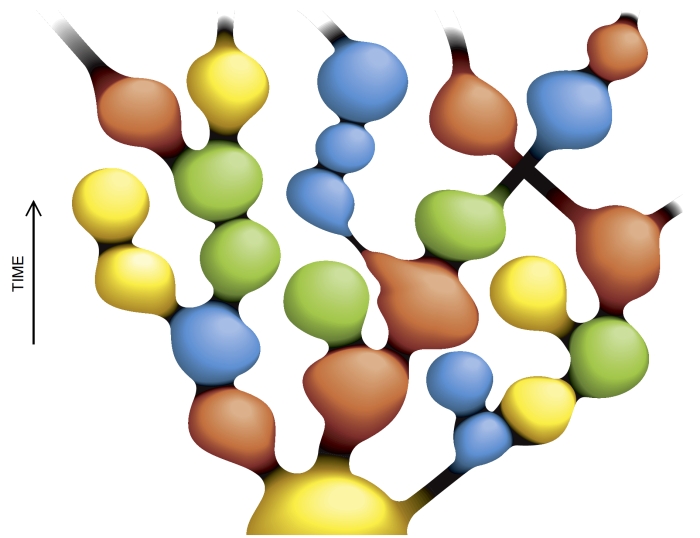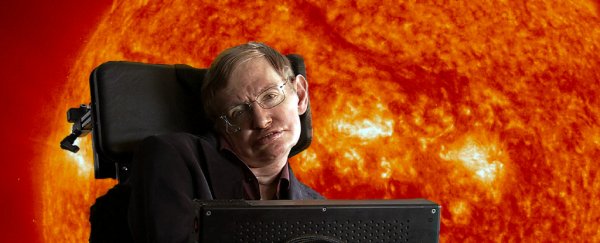Groundbreaking physicist Stephen Hawking left us one last shimmering piece of brilliance before he died: his final paper, detailing his last theory on the origin of the Universe, co-authored with Thomas Hertog from KU Leuven.
The paper, published today in the Journal of High Energy Physics, puts forward that the Universe is far less complex than current multiverse theories suggest.
It's based around a concept called eternal inflation, first introduced in 1979 and published in 1981.
After the Big Bang, the Universe experienced a period of exponential inflation. Then it slowed down, and the energy converted into matter and radiation.
However, according to the theory of eternal inflation, some bubbles of space stopped inflating or slowed on a stopping trajectory, creating a small fractal dead-end of static space.
Meanwhile, in other bubbles of space, because of quantum effects, inflation never stops - leading to an infinite number of multiverses.
Everything we see in our observable Universe, according to this theory, is contained in just one of these bubbles - in which inflation has stopped, allowing for the formation of stars and galaxies.
 Visualisation of the inflating multiverse. (A. Linde/Stanford University)
Visualisation of the inflating multiverse. (A. Linde/Stanford University)
"The usual theory of eternal inflation predicts that globally our universe is like an infinite fractal, with a mosaic of different pocket universes, separated by an inflating ocean," Hawking explained.
"The local laws of physics and chemistry can differ from one pocket universe to another, which together would form a multiverse. But I have never been a fan of the multiverse. If the scale of different universes in the multiverse is large or infinite the theory can't be tested."
Even one of the original architects of the eternal inflation model has disavowed it in recent years.
Paul Steinhardt, physicist at Princeton University, has gone on record saying that the theory took the problem it was meant to solve - to make the Universe, well, universally consistent with our observations - and just shifted it onto a new model.
Hawking and Hertog are now saying that the eternal inflation model is wrong. This is because Einstein's theory of general relativity breaks down on quantum scales.
"The problem with the usual account of eternal inflation is that it assumes an existing background universe that evolves according to Einstein's theory of general relativity and treats the quantum effects as small fluctuations around this," Hertog explained.
"However, the dynamics of eternal inflation wipes out the separation between classical and quantum physics. As a consequence, Einstein's theory breaks down in eternal inflation."
The new theory is based on string theory, one of the frameworks that attempts to reconcile general relativity with quantum theory by replacing the point-like particles in particle physics with tiny, vibrating one-dimensional strings.
In string theory, the holographic principle proposes that a volume of space can be described on a lower-dimensional boundary; so the universe is like a hologram, in which physical reality in 3D spaces can be mathematically reduced to 2D projections on their surfaces.
The researchers developed a variation of the holographic principle that projects the time dimension in eternal inflation, which allowed them to describe the concept without having to rely on general relativity.
This then allowed them to mathematically reduce eternal inflation to a timeless state on a spatial surface at the beginning of the Universe - a hologram of eternal inflation.
"When we trace the evolution of our universe backwards in time, at some point we arrive at the threshold of eternal inflation, where our familiar notion of time ceases to have any meaning," said Hertog.
In 1983, Hawking and another researcher, physicist James Hartle, proposed what is known as the 'no boundary theory' or the 'Hartle-Hawking state'. They proposed that, prior to the Big Bang, there was space, but no time. So the Universe, when it began, expanded from a single point, but doesn't have a boundary.
According to the new theory, the early Universe did have a boundary, and that's allowed Hawking and Hertog to derive more reliable predictions about the structure of the Universe.
"We predict that our universe, on the largest scales, is reasonably smooth and globally finite. So it is not a fractal structure," Hawking said.
It's a result that doesn't disprove multiverses, but reduces them to a much smaller range - which means that multiverse theory may be easier to test in the future, if the work can be replicated and confirmed by other physicists.
Hertog plans to test it by looking for gravitational waves that could have been generated by eternal inflation.
These waves are too large to be detected by LIGO, but future gravitational wave interferometers such as space-based LISA, and future studies of the cosmic microwave background, may reveal them.
The team's research has been published in the Journal of High Energy Physics, and can be read in full on arXiv. Good luck.
